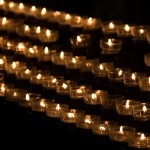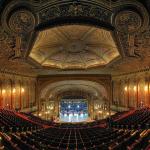The modern age began, let’s say, in 1500. That date is precise enough to include two pioneers of modernity. Christopher Columbus made his trans-Atlantic journey and was discovered by Native-Americans in 1492. Martin Luther (1483-1546) took a 16 ounce hammer to the door of All Saints Church on the hollowed eve of that church’s feast, October 31, 1517. The modern age is characterized by global travel and commerce (Columbus) and by the primacy of the individual over authoritarian institutions (Luther).
Other features of what we call modern life were introduced over 300 years before 1517, explains Adolf Holl in one of the three or four best biographies of St. Francis of Assisi (1181-1226), The Last Christian (Doubleday, 1980). The book begins with reference to two clocks. Monasteries and large churches long maintained rope-pulled bells to mark the liturgical hours: Lauds at dawn, Vespers in the evening and Compline at bedtime. But the bell clock was solar-timed; which meant early Lauds in summer, later in winter. Tournai in Belgium obtained a degree of autonomy from feudal counts and lords in 1188. That year its merchants built the first belfry or bell tower designed for town business, standard time year round. It was subsequently elevated and still operates. A Tournai wall clock sells today for about $60. In 1309 Milan in Italy installed a fully-mechanical clock set to secular time. From then until now we use a machine to arrive at business on time. A replica Milan tabletop clock now sells for anywhere from $14 to $80.
“For one last time, before the forces of progress thundered off on their triumphant path, one man looked into the motivating thrust behind the whole thing and decisively rejected it,” writes Holl. When time took over the public square, St. Francis stopped time. And what was that motivating thrust? St. Francis’ confrontation with his apparel merchant father is well-known. In its dramatic moment, St. Francis took off all his clothes in a public setting and threw them along with his money pouch at his father. Until now Pietro Bernardone was my father, St. Francis yelled. From now on only Our Father who is in heaven is my father. There was never reconciliation. Thinking over what led to his shocking behavior, St. Francis keyed onto one word that was common to each conflict with his father: money. St. Francis committed himself to ending all association with money. “It became the enemy he would fight inexorably for the rest of his days,” says Holl. St. Francis was keenly interested in climbing the social ladder…climbing its rungs downward. At every moment that he thought he had compromised, that he wasn’t radical enough, he took one more step down. For you see, St. Francis’ place and time revealed another feature of what we call modern life. His setting was “the cradle of modern capitalism.” His rejection of money explains why he was not attracted to the medieval monasteries, of which there were many. It was within the monasteries, Holl continues, that the basic values of capitalism developed—“purposeful rationality, discipline, abnegation, enterprise and inventiveness.” The monasteries were the first factories. His rejection of money explains why his followers (the Franciscans) are not monks. They are iterant preachers, called friars. Although he rejected all previews of modernity, St. Francis did not run away. He was not a hermit. He preached outdoors, mostly by gestures. “He needed spectators and he got them,” says Holl. A new movie will bring Jerry Rubin (1938-1994), the premier 1960s yippie, back to public attention. St. Francis and Rubin are different, but they share a fondness for small counter-capitalism gestures. On one of his romps, Rubin obtained a pass for the viewers’ gallery above the floor of the New York Stock Exchange. He pulled hundreds of dollar bills out of his pocket and let them fly. Predictably, the floor traders, the foot soldiers of capitalism, scrambled to collect the money. The exchange was forced to briefly halt trading.
A few years ago one of my students asserted that “St. Francis was a failure.” He hardly reformed the church, she said. It is more corrupt than ever. His religious order has many buildings and has its share of scandal. Nor did St. Francis do anything to stop the evils of the modern age from gaining dominance. I’m not sure she was correct. I’ve had conversations with many young adults who find their high-powered career unsatisfying, who are discontent with the status quo. I regularly meet young adults who, at least in a portion of their life, engage in counter-capitalism. For example, they participate in the slow food movement, the slow fashion movement, the green movement and more. Whenever appropriate I suggest a good biography of St. Francis to these idealists.
Those young adults who know something about St. Francis–whose feast day is Sunday, October 4, 2020–universally relate to the stories about birds and other animals. These young adults also like his association with the environmental movement. However, his need for institutions is a prohibitive block that stops young adults from fully embracing St. Francis’ approach to a meaningful life. How could he retain affection for institutions while seeing so much corruption in the church and while enduring so much disappointment within his fledgling religious order? In caring about institutions, St. Francis was not like Jerry Rubin. To be continued…
Droel edits INITIATIVES (PO Box 291102, Chicago, IL 60629), a print newsletter about faith and work.









